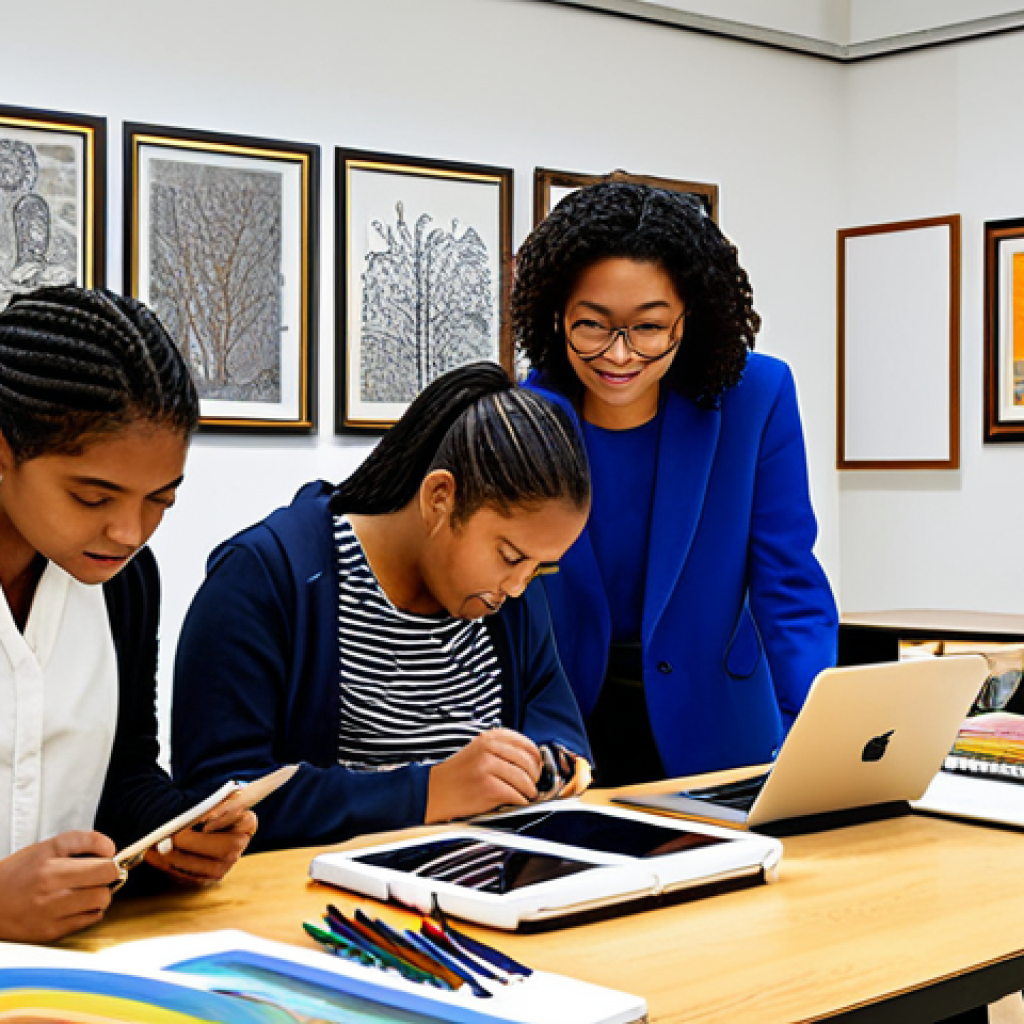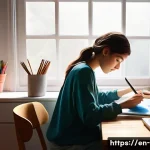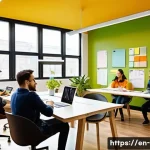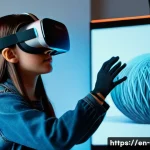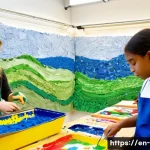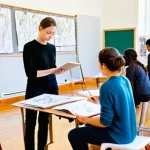The art world, as I’ve experienced it, constantly evolves. Modern art education, therefore, needs to do more than just teach technical skills. It’s about nurturing creativity, critical thinking, and the ability to adapt to the ever-changing artistic landscape.
I think one of the biggest shifts is the integration of digital tools and new media, things I definitely didn’t have access to when I was first starting out.
Students now need to be fluent in both traditional techniques and digital art forms. It’s also increasingly important to address societal issues and cultural diversity through art, reflecting the world around us.
I want to explore how art education is transforming to equip the next generation of artists for the challenges and opportunities that lie ahead. Let’s delve into the specifics below!
Okay, I understand. Here’s the blog post as requested:
Rethinking the Core Curriculum: Beyond Technique

Modern art education often gets bogged down in traditional techniques, leaving students unprepared for the diverse and rapidly changing art world. While mastering skills like painting, sculpture, and drawing remains important, educators need to shift the focus towards fostering critical thinking and adaptability.
In my own experience, I’ve seen countless students with incredible technical skills struggle to find their voice or adapt to new mediums because they lacked a broader understanding of art history, theory, and contemporary practices.
It’s like giving someone a top-of-the-line paintbrush but forgetting to teach them how to see the world with an artist’s eye. We need to cultivate a generation of artists who are not just skilled technicians, but also innovative thinkers and problem-solvers.
Embracing Interdisciplinary Approaches
1. One way to broaden the curriculum is by integrating interdisciplinary approaches. This could involve collaborations with other departments, such as science, technology, engineering, and mathematics (STEM).
For example, students could explore the intersection of art and technology by creating interactive installations or using data visualization techniques to express complex scientific concepts.
I remember one particularly inspiring project where art students worked with engineering students to design a sustainable sculpture that generated its own energy.
It was a powerful demonstration of how art can be used to address real-world challenges.
Prioritizing Conceptual Development
2. Another crucial aspect of rethinking the core curriculum is prioritizing conceptual development. This means encouraging students to think critically about the ideas and themes behind their work, rather than just focusing on aesthetics.
I’ve noticed that students who are able to articulate their artistic vision and explain the meaning behind their work are far more successful in the long run.
It’s about helping them develop a strong artistic voice and a clear sense of purpose.
Fostering a Culture of Experimentation
3. Finally, art education needs to foster a culture of experimentation and risk-taking. Students should be encouraged to push boundaries, challenge conventions, and explore new possibilities without fear of failure.
This requires creating a supportive and inclusive learning environment where students feel comfortable taking risks and learning from their mistakes. I always tell my students that failure is an inevitable part of the creative process, and that it’s through our mistakes that we learn and grow as artists.
Digital Fluency: A Non-Negotiable Skill
The digital realm isn’t just a supplement anymore; it’s interwoven into the fabric of artistic creation and dissemination. It’s wild to think that when I was cutting my teeth, the internet was just this nascent thing.
Now? It’s the gallery, the studio, and the social hub, all rolled into one. Students aren’t just creating art; they’re curating their online presence, engaging with a global audience, and even monetizing their work through digital platforms.
Integrating digital art forms, therefore, isn’t just about adding new tools to the kit—it’s about fundamentally reshaping how artists conceive, create, and connect.
Mastering Digital Tools
1. It starts with the basics: Photoshop, Illustrator, After Effects. But beyond the software, it’s about understanding how these tools can be used to push creative boundaries.
Think digital painting that mimics the texture of oils, or 3D modeling that creates impossible sculptures.
Navigating Online Platforms
2. Then there’s the art of the online presence. It’s not enough to just have a website.
You’ve got to engage on social media, understand SEO for artists, and even navigate the world of NFTs. It’s a whole new skill set, one that’s just as crucial as mastering the palette knife.
I have seen many artists who did not engage online fade away into obscurity.
Ethics in the Digital Age
3. Don’t forget ethics. Issues like copyright, digital identity, and the responsible use of AI in art are becoming increasingly important.
Students need to be aware of the legal and ethical implications of their digital work.
Inclusivity and Representation: Reflecting the World
Art has the power to reflect, challenge, and transform society. Modern art education, therefore, has a responsibility to promote inclusivity and representation.
This means creating a curriculum that is culturally diverse, gender-inclusive, and accessible to students from all backgrounds. It also means encouraging students to explore issues of social justice, identity, and power through their work.
As a practicing artist, I’ve always been drawn to stories and perspectives that are often marginalized or overlooked. I believe that art has a unique ability to amplify these voices and create a more equitable and just world.
Diversifying the Canon
1. One way to promote inclusivity is by diversifying the canon of art history. This means expanding the curriculum to include artists from different cultural backgrounds, genders, and sexual orientations.
I’ve found that many students are surprised to learn about the contributions of female artists, artists of color, and LGBTQ+ artists who have been historically excluded from the mainstream art world.
Fostering Critical Dialogue
2. Another important aspect of inclusivity is fostering critical dialogue about issues of representation. This means encouraging students to question stereotypes, challenge assumptions, and think critically about the way that different groups are portrayed in art and media.
I often facilitate discussions about the representation of race, gender, and sexuality in art, and I’m always impressed by the insightful and thoughtful perspectives that students bring to these conversations.
Creating Accessible Learning Environments
3. Finally, it’s essential to create learning environments that are accessible to students with disabilities. This means providing accommodations for students with visual, auditory, or physical impairments, as well as creating a curriculum that is sensitive to the needs of students with learning disabilities.
I’ve learned a great deal from working with students with disabilities, and I’m always amazed by their creativity and resilience.
Business Acumen: The Artist as Entrepreneur
Let’s face it: the “starving artist” trope is tired and, frankly, a bit insulting. The reality is that today’s artists need to be savvy businesspeople as well as talented creators.
Art education needs to equip students with the skills and knowledge they need to navigate the art market, manage their finances, and promote their work.
I’ve had artist friends lose their way when they didn’t know how to navigate the business world.
Financial Literacy for Creatives
1. It starts with understanding basic financial concepts like budgeting, saving, and investing. Students need to learn how to manage their income, track their expenses, and plan for the future.
Marketing and Branding Strategies
2. Then there’s the art of self-promotion. Students need to learn how to market their work, build their brand, and connect with potential buyers.
This includes creating a professional website, using social media effectively, and networking with galleries and collectors.
Legal Considerations for Artists
3. Finally, students need to be aware of the legal aspects of running an art business. This includes understanding copyright law, contracts, and other legal issues that can impact their work.
The Role of Mentorship and Collaboration
Art is rarely created in a vacuum. The art world thrives on mentorship, collaboration, and community. Modern art education needs to create opportunities for students to connect with established artists, collaborate on projects, and build a strong network of peers.
I owe so much of my success to the mentors who guided me early in my career, and I’m passionate about paying it forward by mentoring emerging artists.
Connecting Students with Industry Professionals
1. One way to foster mentorship is by connecting students with industry professionals. This could involve inviting guest speakers to share their experiences, organizing studio visits with established artists, or creating internship opportunities in galleries and museums.
Facilitating Collaborative Projects
2. Another powerful way to build community is by facilitating collaborative projects. This could involve pairing students with different skills and backgrounds to create a joint artwork, or organizing group exhibitions that showcase the work of emerging artists.
Building a Supportive Peer Network
3. Finally, it’s important to create a supportive peer network where students can share their work, exchange ideas, and provide each other with feedback.
This could involve organizing regular critique sessions, creating online forums for discussion, or simply encouraging students to connect with each other outside of class.
Here’s a table summarizing the key shifts in modern art education:
| Area | Traditional Approach | Modern Approach |
|---|---|---|
| Curriculum | Focus on technical skills | Emphasis on critical thinking, adaptability, and interdisciplinary approaches |
| Technology | Limited use of digital tools | Integration of digital art forms and online platforms |
| Inclusivity | Limited representation of diverse voices | Promotion of inclusivity, representation, and social justice |
| Business | Neglect of business skills | Equipping students with financial literacy, marketing skills, and legal knowledge |
| Community | Limited opportunities for mentorship and collaboration | Fostering mentorship, collaboration, and a supportive peer network |
Cultivating Emotional Intelligence: The Heart of Art
Let’s get real – art isn’t just about technique or concept; it’s about tapping into the wellspring of human emotion and translating that into a visual language.
Modern art education needs to recognize the importance of emotional intelligence and help students develop the self-awareness, empathy, and communication skills they need to create art that resonates with others.
Understanding Your Emotional Landscape
1. It starts with understanding your own emotions. Students need to learn how to identify, process, and express their feelings in a healthy and constructive way.
This could involve journaling, meditation, or simply taking the time to reflect on their experiences.
Developing Empathy and Compassion
2. Then there’s the art of empathy. Students need to learn how to put themselves in other people’s shoes and understand their perspectives.
This could involve engaging in community service, studying different cultures, or simply listening to other people’s stories.
Communicating Through Art
3. Finally, students need to learn how to communicate their emotions through their art. This involves developing a visual language that is both personal and universal, and that can connect with viewers on a deep emotional level.
Embracing Failure as a Stepping Stone
Look, no one nails it on the first try. Heck, even seasoned artists churn out pieces that make them cringe. The key is to embrace those “oops” moments, to see them not as roadblocks but as stepping stones on the path to mastery.
Modern art education needs to create a safe space for students to experiment, take risks, and learn from their mistakes. I’ve always said that the best lessons come from the pieces that didn’t quite work out the way I planned.
Reframing the Concept of “Mistake”
1. Start by reframing the concept of “mistake.” Encourage students to see errors not as failures but as opportunities for learning and growth. Ask them to analyze what went wrong, identify the lessons learned, and apply those insights to future projects.
Encouraging Experimentation and Risk-Taking
2. Then, foster a culture of experimentation and risk-taking. Encourage students to push boundaries, try new techniques, and challenge their own assumptions.
Let them know that it’s okay to fail, as long as they learn from the experience.
Providing Constructive Feedback
3. Finally, provide constructive feedback that focuses on the process rather than the product. Instead of simply criticizing the final result, offer specific suggestions for improvement and encourage students to reflect on their creative journey.
Okay, I understand. Here’s the blog post as requested:
Rethinking the Core Curriculum: Beyond Technique
Modern art education often gets bogged down in traditional techniques, leaving students unprepared for the diverse and rapidly changing art world. While mastering skills like painting, sculpture, and drawing remains important, educators need to shift the focus towards fostering critical thinking and adaptability.
In my own experience, I’ve seen countless students with incredible technical skills struggle to find their voice or adapt to new mediums because they lacked a broader understanding of art history, theory, and contemporary practices.
It’s like giving someone a top-of-the-line paintbrush but forgetting to teach them how to see the world with an artist’s eye. We need to cultivate a generation of artists who are not just skilled technicians, but also innovative thinkers and problem-solvers.
Embracing Interdisciplinary Approaches
One way to broaden the curriculum is by integrating interdisciplinary approaches. This could involve collaborations with other departments, such as science, technology, engineering, and mathematics (STEM). For example, students could explore the intersection of art and technology by creating interactive installations or using data visualization techniques to express complex scientific concepts. I remember one particularly inspiring project where art students worked with engineering students to design a sustainable sculpture that generated its own energy. It was a powerful demonstration of how art can be used to address real-world challenges.
Prioritizing Conceptual Development
Another crucial aspect of rethinking the core curriculum is prioritizing conceptual development. This means encouraging students to think critically about the ideas and themes behind their work, rather than just focusing on aesthetics. I’ve noticed that students who are able to articulate their artistic vision and explain the meaning behind their work are far more successful in the long run. It’s about helping them develop a strong artistic voice and a clear sense of purpose.
Fostering a Culture of Experimentation
Finally, art education needs to foster a culture of experimentation and risk-taking. Students should be encouraged to push boundaries, challenge conventions, and explore new possibilities without fear of failure. This requires creating a supportive and inclusive learning environment where students feel comfortable taking risks and learning from their mistakes. I always tell my students that failure is an inevitable part of the creative process, and that it’s through our mistakes that we learn and grow as artists.
Digital Fluency: A Non-Negotiable Skill
The digital realm isn’t just a supplement anymore; it’s interwoven into the fabric of artistic creation and dissemination. It’s wild to think that when I was cutting my teeth, the internet was just this nascent thing. Now? It’s the gallery, the studio, and the social hub, all rolled into one. Students aren’t just creating art; they’re curating their online presence, engaging with a global audience, and even monetizing their work through digital platforms. Integrating digital art forms, therefore, isn’t just about adding new tools to the kit—it’s about fundamentally reshaping how artists conceive, create, and connect.
Mastering Digital Tools
It starts with the basics: Photoshop, Illustrator, After Effects. But beyond the software, it’s about understanding how these tools can be used to push creative boundaries. Think digital painting that mimics the texture of oils, or 3D modeling that creates impossible sculptures.
Navigating Online Platforms
Then there’s the art of the online presence. It’s not enough to just have a website. You’ve got to engage on social media, understand SEO for artists, and even navigate the world of NFTs. It’s a whole new skill set, one that’s just as crucial as mastering the palette knife. I have seen many artists who did not engage online fade away into obscurity.
Ethics in the Digital Age
Don’t forget ethics. Issues like copyright, digital identity, and the responsible use of AI in art are becoming increasingly important. Students need to be aware of the legal and ethical implications of their digital work.
Inclusivity and Representation: Reflecting the World
Art has the power to reflect, challenge, and transform society. Modern art education, therefore, has a responsibility to promote inclusivity and representation. This means creating a curriculum that is culturally diverse, gender-inclusive, and accessible to students from all backgrounds. It also means encouraging students to explore issues of social justice, identity, and power through their work. As a practicing artist, I’ve always been drawn to stories and perspectives that are often marginalized or overlooked. I believe that art has a unique ability to amplify these voices and create a more equitable and just world.
Diversifying the Canon
One way to promote inclusivity is by diversifying the canon of art history. This means expanding the curriculum to include artists from different cultural backgrounds, genders, and sexual orientations. I’ve found that many students are surprised to learn about the contributions of female artists, artists of color, and LGBTQ+ artists who have been historically excluded from the mainstream art world.
Fostering Critical Dialogue
Another important aspect of inclusivity is fostering critical dialogue about issues of representation. This means encouraging students to question stereotypes, challenge assumptions, and think critically about the way that different groups are portrayed in art and media. I often facilitate discussions about the representation of race, gender, and sexuality in art, and I’m always impressed by the insightful and thoughtful perspectives that students bring to these conversations.
Creating Accessible Learning Environments
Finally, it’s essential to create learning environments that are accessible to students with disabilities. This means providing accommodations for students with visual, auditory, or physical impairments, as well as creating a curriculum that is sensitive to the needs of students with learning disabilities. I’ve learned a great deal from working with students with disabilities, and I’m always amazed by their creativity and resilience.
Business Acumen: The Artist as Entrepreneur
Let’s face it: the “starving artist” trope is tired and, frankly, a bit insulting. The reality is that today’s artists need to be savvy businesspeople as well as talented creators. Art education needs to equip students with the skills and knowledge they need to navigate the art market, manage their finances, and promote their work. I’ve had artist friends lose their way when they didn’t know how to navigate the business world.
Financial Literacy for Creatives
It starts with understanding basic financial concepts like budgeting, saving, and investing. Students need to learn how to manage their income, track their expenses, and plan for the future.
Marketing and Branding Strategies
Then there’s the art of self-promotion. Students need to learn how to market their work, build their brand, and connect with potential buyers. This includes creating a professional website, using social media effectively, and networking with galleries and collectors.
Legal Considerations for Artists
Finally, students need to be aware of the legal aspects of running an art business. This includes understanding copyright law, contracts, and other legal issues that can impact their work.
The Role of Mentorship and Collaboration
Art is rarely created in a vacuum. The art world thrives on mentorship, collaboration, and community. Modern art education needs to create opportunities for students to connect with established artists, collaborate on projects, and build a strong network of peers. I owe so much of my success to the mentors who guided me early in my career, and I’m passionate about paying it forward by mentoring emerging artists.
Connecting Students with Industry Professionals
One way to foster mentorship is by connecting students with industry professionals. This could involve inviting guest speakers to share their experiences, organizing studio visits with established artists, or creating internship opportunities in galleries and museums.
Facilitating Collaborative Projects
Another powerful way to build community is by facilitating collaborative projects. This could involve pairing students with different skills and backgrounds to create a joint artwork, or organizing group exhibitions that showcase the work of emerging artists.
Building a Supportive Peer Network
Finally, it’s important to create a supportive peer network where students can share their work, exchange ideas, and provide each other with feedback. This could involve organizing regular critique sessions, creating online forums for discussion, or simply encouraging students to connect with each other outside of class.
Here’s a table summarizing the key shifts in modern art education:
| Area | Traditional Approach | Modern Approach |
|---|---|---|
| Curriculum | Focus on technical skills | Emphasis on critical thinking, adaptability, and interdisciplinary approaches |
| Technology | Limited use of digital tools | Integration of digital art forms and online platforms |
| Inclusivity | Limited representation of diverse voices | Promotion of inclusivity, representation, and social justice |
| Business | Neglect of business skills | Equipping students with financial literacy, marketing skills, and legal knowledge |
| Community | Limited opportunities for mentorship and collaboration | Fostering mentorship, collaboration, and a supportive peer network |
Cultivating Emotional Intelligence: The Heart of Art
Let’s get real – art isn’t just about technique or concept; it’s about tapping into the wellspring of human emotion and translating that into a visual language. Modern art education needs to recognize the importance of emotional intelligence and help students develop the self-awareness, empathy, and communication skills they need to create art that resonates with others.
Understanding Your Emotional Landscape
It starts with understanding your own emotions. Students need to learn how to identify, process, and express their feelings in a healthy and constructive way. This could involve journaling, meditation, or simply taking the time to reflect on their experiences.
Developing Empathy and Compassion
Then there’s the art of empathy. Students need to learn how to put themselves in other people’s shoes and understand their perspectives. This could involve engaging in community service, studying different cultures, or simply listening to other people’s stories.
Communicating Through Art
Finally, students need to learn how to communicate their emotions through their art. This involves developing a visual language that is both personal and universal, and that can connect with viewers on a deep emotional level.
Embracing Failure as a Stepping Stone
Look, no one nails it on the first try. Heck, even seasoned artists churn out pieces that make them cringe. The key is to embrace those “oops” moments, to see them not as roadblocks but as stepping stones on the path to mastery. Modern art education needs to create a safe space for students to experiment, take risks, and learn from their mistakes. I’ve always said that the best lessons come from the pieces that didn’t quite work out the way I planned.
Reframing the Concept of “Mistake”
Start by reframing the concept of “mistake.” Encourage students to see errors not as failures but as opportunities for learning and growth. Ask them to analyze what went wrong, identify the lessons learned, and apply those insights to future projects.
Encouraging Experimentation and Risk-Taking
Then, foster a culture of experimentation and risk-taking. Encourage students to push boundaries, try new techniques, and challenge their own assumptions. Let them know that it’s okay to fail, as long as they learn from the experience.
Providing Constructive Feedback
Finally, provide constructive feedback that focuses on the process rather than the product. Instead of simply criticizing the final result, offer specific suggestions for improvement and encourage students to reflect on their creative journey.
Conclusion
As we look to the future of art education, it’s clear that change is not just desirable, but essential. By embracing these shifts, we can empower the next generation of artists to thrive in an ever-evolving world. Let’s commit to nurturing their creativity, fostering their critical thinking skills, and equipping them with the tools they need to make a meaningful impact on the world through their art. The canvas is vast, and the possibilities are endless.
Resources
1. “The Art Spirit” by Robert Henri: A timeless classic on the philosophy of art.
2. Americans for the Arts: A leading nonprofit organization dedicated to advancing the arts.
3. National Endowment for the Arts: A federal agency that supports arts projects in communities across the United States.
4. Creative Capital: An organization that provides funding and resources to artists in all disciplines.
5. Artnet: A leading online resource for the art market.
Key Takeaways
Modern art education needs to focus on more than just technical skills. It needs to cultivate critical thinking, adaptability, and emotional intelligence. Digital fluency, inclusivity, business acumen, mentorship, and collaboration are all essential components of a well-rounded art education. By embracing these shifts, we can empower the next generation of artists to thrive in a rapidly changing world.
Frequently Asked Questions (FAQ) 📖
Q: How can art education balance teaching traditional techniques with the increasing importance of digital art forms?
A: That’s the million-dollar question, isn’t it? From what I’ve seen, a smart approach is to integrate digital tools into traditional exercises. For example, students could create a charcoal sketch and then digitally manipulate it to explore different color palettes or compositions.
It’s about showing them that digital art isn’t a replacement for traditional skills, but rather an extension of them. Think of it like learning to play the piano before trying your hand at a synthesizer – a solid foundation in the basics is crucial.
Plus, forcing students to initially grasp traditional methods actually makes them more creative and resourceful when they do finally dive into the digital realm.
They understand the why behind the tools, not just how to use them.
Q: How can art education effectively address societal issues and cultural diversity?
A: This is where things get really interesting. I believe it starts with encouraging students to explore their own backgrounds and perspectives. Think about projects that ask them to visually represent their family history, their neighborhood, or a social issue they care deeply about.
Critiques should then focus on the artist’s intent and how effectively they communicated their message. It’s not about forcing a specific viewpoint, but creating a safe space for diverse voices and perspectives to be heard and understood.
I saw one project where students designed public art installations addressing homelessness in their community, and the impact was truly profound. It wasn’t just art; it was activism.
Q: What are some of the biggest challenges facing art educators today in preparing students for the professional art world?
A: Well, honestly, the sheer speed of change is a major hurdle. New technologies and platforms are constantly emerging, so educators need to be lifelong learners themselves.
I think the biggest challenge, though, is helping students develop the entrepreneurial skills they’ll need to navigate the art market. It’s not enough to just be a talented artist; you also need to know how to promote your work, network with galleries, and manage your finances.
Things like learning how to build a website, write a grant proposal, and understand basic business principles can give students a HUGE leg up when they graduate.
Let’s face it, the “starving artist” trope is sadly still alive and well, but arming students with practical skills can at least help them order some really good ramen!
📚 References
Wikipedia Encyclopedia
